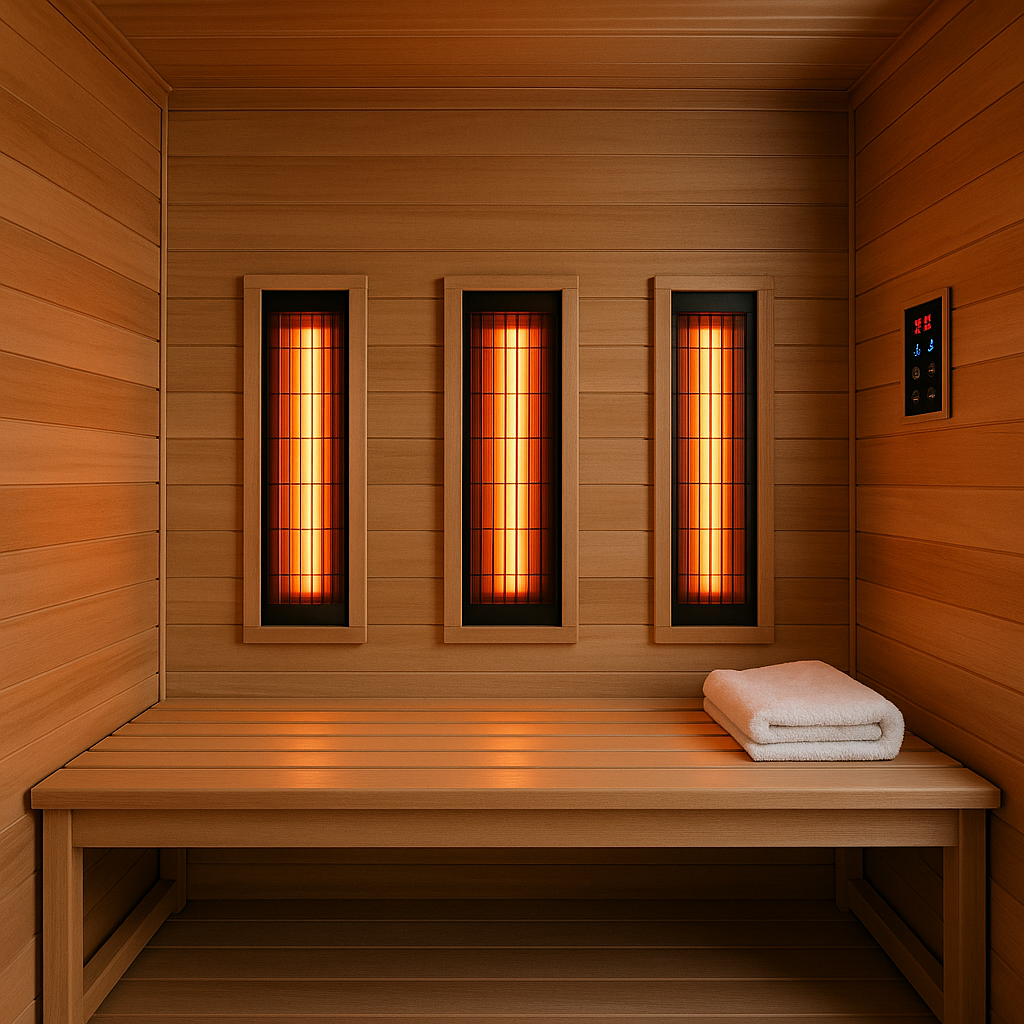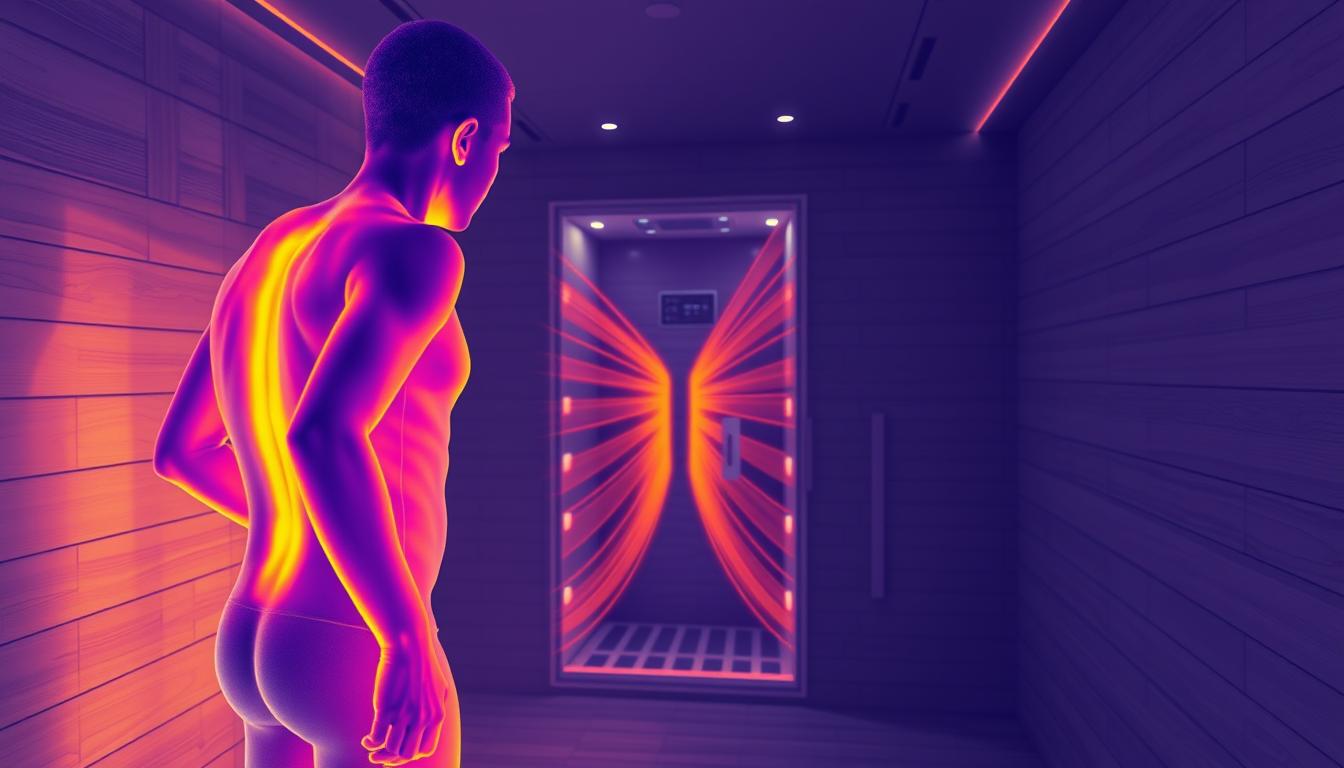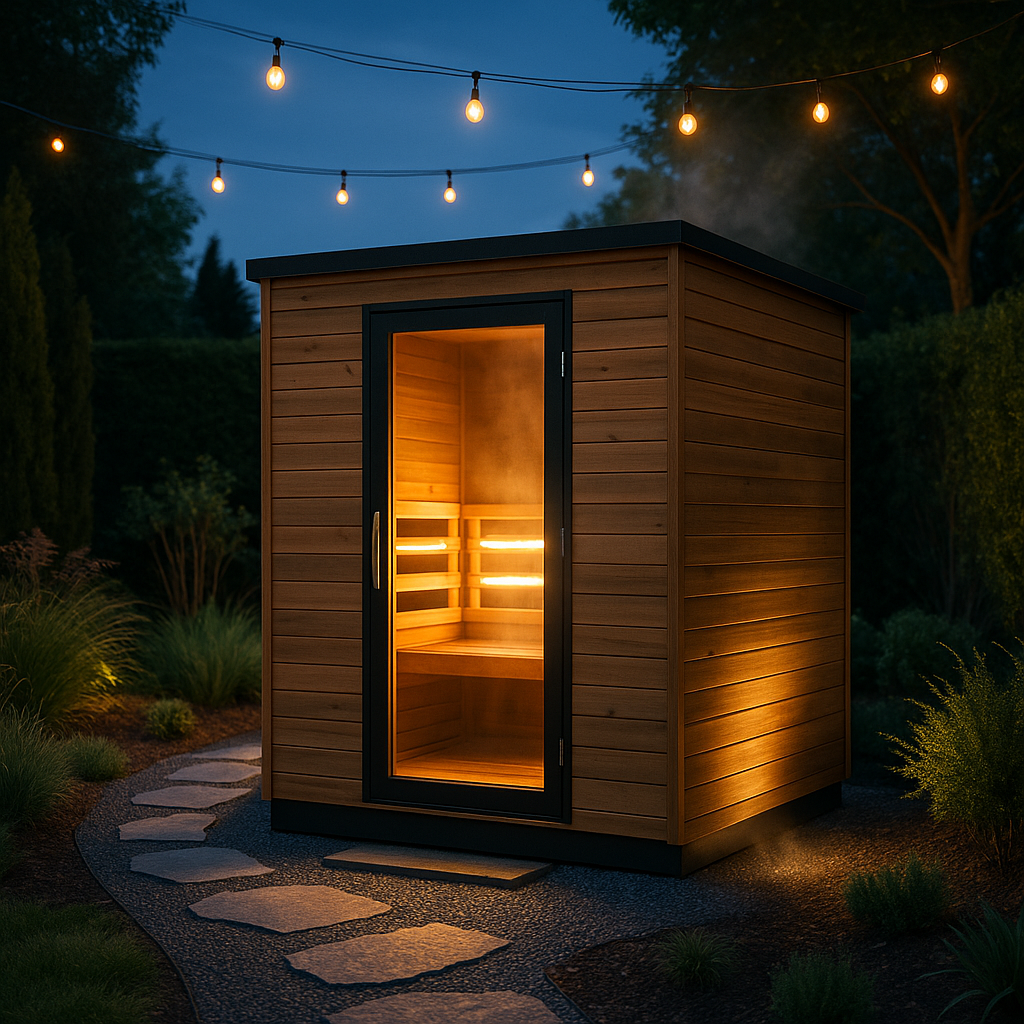
Infrared Sauna Calorie Burn: The Facts You Need to Know
Infrared saunas have become a popular choice in modern wellness routines. Unlike traditional saunas, they use infrared light to heat the body directly. This method is known for its relaxing and detoxifying effects.

Many people wonder about the role of these saunas in weight management. While they can help with temporary water loss, fat reduction requires a balanced approach. Combining sauna sessions with a healthy diet and regular exercise yields the best results.
Studies, such as one from Binghamton University, highlight the potential benefits of infrared saunas. These include stress relief, improved circulation, and enhanced relaxation. However, it’s important to set realistic expectations and prioritize safety.
Key Takeaways
- Infrared saunas are gaining popularity for their wellness benefits.
- They help with detoxification and stress relief.
- Weight management requires a combination of sauna use, diet, and exercise.
- Scientific studies support their health benefits.
- Safety should always be a priority when using saunas.
What Is an Infrared Sauna?
Infrared saunas are a modern wellness innovation with roots in Japanese technology. They use infrared light to directly warm the body, offering a gentler and more efficient experience compared to traditional methods. These saunas are designed to provide deep, therapeutic heat for relaxation and detoxification.
https://www.youtube.com/watch?v=chKti38y1KE
How Does an Infrared Sauna Work?
Infrared saunas operate by emitting light waves that penetrate the skin and warm the body directly. Unlike traditional saunas, which heat the air around you, infrared versions use radiation to transfer heat efficiently. This method allows for lower temperatures, typically between 110°F and 140°F, making the experience more comfortable.
The light waves can reach up to 1.5 inches into the muscles, promoting relaxation and improved circulation. This deep penetration also helps release toxins, with sweat composed of about 80% water and 20% impurities. The process is energy-efficient and gentle on the respiratory system, making it ideal for longer sessions.
Infrared Sauna vs. Traditional Sauna: Key Differences
Traditional saunas, originating from Finland, use heated rocks or steam to warm the air, which then heats the body. In contrast, infrared saunas rely on panels that emit light waves. This difference results in lower temperatures and a more comfortable environment.
Traditional saunas often operate between 150°F and 212°F, creating a high-humidity atmosphere. Infrared versions, however, maintain lower humidity levels, making breathing easier. Additionally, infrared saunas are more energy-efficient, as they directly warm the body without heating the surrounding air.
Materials also differ. Traditional saunas are typically made of cedar, while infrared versions often use ceramic heaters or advanced technologies like Clearlight® panels. These innovations ensure a consistent and effective heat experience during each session.
How Many Calories Are Burned in an Infrared Sauna?
Many people are curious about the energy expenditure during infrared sauna sessions. While the exact number varies, studies suggest that these sessions can contribute to energy usage comparable to light physical activities. Let’s break down the details.

Calorie Burn in a 30-Minute Session
During a 30-minute session, energy usage typically ranges between 250 and 400 units. This is equivalent to a brisk walk or light jog. Factors like weight, BMI, and hydration levels play a role in determining the exact amount.
For example, a person weighing 150 pounds may use fewer units compared to someone weighing 200 pounds. Staying hydrated is crucial, as dehydration can skew results and lead to misinterpretation.
Calorie Burn in a 40-Minute Session
Extending the session to 40 minutes increases energy expenditure to between 300 and 690 units. This range is similar to running a mile or engaging in moderate-intensity exercise. Over time, cumulative effects can enhance metabolic response.
Gender differences also influence outcomes. Men often experience higher energy usage due to greater muscle mass, while women may see progressive benefits over multiple sessions.
It’s important to note that while these sessions can support weight management, they should complement a balanced diet and regular exercise. Misinterpreting temporary water loss as fat reduction can lead to unrealistic expectations.
Infrared Sauna and Weight Loss: What's the Connection?
Exploring the link between infrared saunas and weight loss reveals fascinating insights. Many people wonder if these sessions can truly help shed pounds or if the effects are temporary. Let’s dive into the science behind it.
https://www.youtube.com/watch?v=9lNNqSH4Wdg
Water Weight vs. Fat Loss
One common misconception is that sweating equals fat loss. In reality, much of the initial weight reduction is due to water weight. A session can lead to a temporary loss of up to 0.65kg, but this is not the same as reducing body fat.
Replenishing electrolytes is crucial after a session. Dehydration can skew results and create a false sense of progress. While losing water weight can feel rewarding, it’s important to focus on long-term strategies for sustainable results.
Can Infrared Saunas Help You Lose Weight?
Infrared saunas may support weight management in several ways. They stimulate mitochondrial biogenesis, which enhances the body’s ability to produce energy. This process can improve metabolic efficiency over time.
Additionally, these sessions may help release glycerol from fat cells, making them available for energy use. Research also suggests that sauna use can modulate cortisol levels, reducing stress-related weight gain.
Combining sauna sessions with other strategies, like intermittent fasting, can amplify results. However, extreme dehydration practices should be avoided to ensure safety and effectiveness.
| Factor | Impact |
|---|---|
| Water Weight | Temporary loss of up to 0.65kg |
| Body Fat | Requires long-term strategies |
| Energy Production | Enhanced through mitochondrial biogenesis |
| Stress Reduction | Modulated cortisol levels |
While infrared saunas can be a helpful tool, they work best when paired with a balanced diet and regular exercise. Understanding the difference between water weight and body fat is key to setting realistic expectations.
Health Benefits of Infrared Saunas Beyond Calorie Burn
Infrared technology offers more than just warmth—it’s a gateway to holistic wellness. While many focus on its role in energy expenditure, the health benefits extend far beyond. From detoxification to stress relief, these sessions can transform your well-being in surprising ways.

Detoxification and Improved Circulation
One of the standout advantages is detoxification. Infrared light penetrates deep into the skin, promoting heavy metal excretion. Studies show that sweat during these sessions contains up to 20% toxins, compared to just 3% in traditional methods.
Improved circulation is another key benefit. Infrared light activates VEGF (vascular endothelial growth factor), which enhances blood flow. Research indicates a 30% improvement in circulation, supporting heart health and overall vitality.
Muscle Recovery and Stress Relief
For those seeking muscle recovery, infrared sessions are a game-changer. The deep heat reduces pain and inflammation, with studies reporting a 57% reduction in chronic fatigue patients. This makes it an ideal choice for athletes or anyone with active lifestyles.
Stress relief is another major perk. Infrared light activates the parasympathetic nervous system, promoting relaxation. It also triggers endorphin release, creating a natural mood boost. This dual action helps combat daily stress and improves mental clarity.
| Benefit | Impact |
|---|---|
| Detoxification | Promotes heavy metal excretion |
| Circulation | 30% improvement in blood flow |
| Muscle Recovery | 57% reduction in chronic pain |
| Stress Relief | Activates parasympathetic nervous system |
Infrared technology is more than a trend—it’s a powerful tool for enhancing your health benefits. Whether you’re looking to detox, recover, or relax, these sessions offer a comprehensive approach to wellness.
Infrared Sauna vs. Traditional Sauna: Which Is Better?
Choosing between an infrared and traditional sauna can be a tough decision for wellness enthusiasts. Both offer unique experiences and benefits, but understanding their differences can help you make the right choice for your needs.

Temperature and Comfort Comparison
One of the biggest differences lies in the temperatures. Traditional saunas typically operate between 70°C and 100°C, creating a hot, steamy environment. Infrared versions, on the other hand, use lower temperatures, usually around 60°C, making them more comfortable for longer sessions.
Infrared saunas also heat the body directly, rather than warming the air. This results in a gentler experience, ideal for those who find traditional methods too intense. Additionally, the lower humidity levels in infrared versions make breathing easier, especially for individuals with respiratory concerns.
Health Benefits of Each
Both types offer impressive health benefits, but they cater to different needs. Traditional saunas are excellent for improving heart rate and cardiovascular health, thanks to their high heat. They also promote sweating, which can aid in detoxification.
Infrared saunas, however, penetrate deeper into the skin, enhancing muscle recovery and reducing inflammation. They are also more energy-efficient and better suited for solo use, making them a convenient option for home wellness routines.
- Traditional saunas are great for social gatherings and intense detox sessions.
- Infrared versions are ideal for solo users and those seeking gentle, deep heat therapy.
- Both can complement a healthy lifestyle, including regular exercise.
Ultimately, the choice depends on your preferences and wellness goals. Whether you prioritize intense heat or a more comfortable experience, both saunas offer unique advantages for enhancing your well-being.
How to Maximize Calorie Burn in an Infrared Sauna
To get the most out of your wellness routine, understanding how to optimize your sessions is key. By focusing on the right habits, you can elevate the impact of your practice and achieve better results. Let’s explore the best ways to enhance your experience.

Optimal Session Length and Frequency
For effective results, aim for sessions lasting between 30 and 40 minutes. This duration allows your body to warm up and respond to the heat without overexertion. According to the Binghamton protocol, a frequency of three times weekly is ideal for consistent benefits.
Timing also matters. Morning sessions can align with your body’s natural circadian rhythm, boosting energy levels for the day. Evening sessions, on the other hand, may promote relaxation and better sleep. Experiment to find what works best for you.
Hydration and Post-Sauna Care
Staying hydrated is crucial before, during, and after your sessions. Dehydration can reduce effectiveness and lead to discomfort. Consider replenishing electrolytes with drinks like coconut water or a homemade mix of water, lemon, and a pinch of salt.
Post-session care is equally important. A contrast shower—alternating between warm and cool water—can enhance circulation and recovery. Additionally, using a PEMF mat or engaging in light stretching can further support muscle relaxation and overall well-being.
| Tip | Benefit |
|---|---|
| Dynamic Stretching | Prepares muscles for heat exposure |
| Electrolyte Drinks | Replenishes lost minerals |
| Contrast Showers | Improves circulation and recovery |
| PEMF Mat Use | Enhances relaxation and muscle recovery |
"The key to maximizing your sessions lies in consistency and proper care. Listen to your body and adjust as needed."
By following these tips, you can make the most of your time and enjoy the full range of benefits. Remember, a balanced approach yields the best results.
What Does the Research Say About Infrared Saunas?
Scientific research sheds light on the effectiveness of infrared technology. Studies have explored its impact on wellness, including energy expenditure and weight management. While findings are promising, it’s essential to examine the evidence critically.
Key Studies on Calorie Burn and Weight Loss
Several studies have investigated the role of infrared sessions in wellness. For example, a 10-person study on chronic fatigue reported improved energy levels among participants. Another study focused on muscle recovery, showing significant reductions in pain and inflammation.
These results suggest potential benefits for weight management. However, the sample sizes were small, limiting broader conclusions. Researchers emphasize the need for larger, more diverse studies to validate these findings.
Limitations of Current Research
While studies offer valuable insights, they have notable limitations. Many rely on small sample sizes, such as the 10-person studies mentioned earlier. This restricts the generalizability of the results.
Other concerns include potential conflicts of interest and gaps in measurement methodologies. For instance, some studies fail to account for long-term adherence rates or biomarker reliability, such as cortisol versus DHEA levels.
Additionally, there’s a lack of female-specific research. Most studies focus on sedentary male participants, leaving a gap in understanding how women respond to infrared therapy.
| Research Aspect | Key Findings |
|---|---|
| Sample Size | Often small, limiting generalizability |
| Measurement Gaps | Biomarker reliability and adherence rates |
| Gender Bias | Focus on male participants |
| Conflict of Interest | Potential influence on study outcomes |
"Future research should prioritize larger, diverse samples to provide more reliable insights into the benefits of infrared therapy."
Who Should Avoid Using an Infrared Sauna?
While infrared therapy offers numerous benefits, it’s not suitable for everyone. Certain people should approach these sessions with caution due to specific health concerns. Understanding who should avoid this technology is crucial for safety and effectiveness.
Health Conditions to Consider
Pregnant individuals are advised to avoid infrared sessions due to potential risks to fetal development. Those with multiple sclerosis may experience worsened symptoms, as heat can affect nerve function. Post-alcohol use is another contraindication, as it can lead to dehydration and dizziness.
People with pacemakers should avoid infrared therapy, as the heat may interfere with the device’s functionality. Lithium medication users are also at risk, as heat can alter drug absorption and lead to complications. Hypotension episodes may occur, especially in those prone to low blood pressure.
Safety Precautions
Individuals with a history of seizures should consult a physician before using infrared technology, as heat can lower the seizure threshold. Sunburn sensitivity is another concern, as infrared light may exacerbate skin irritation. Diuretic medication users should monitor their hydration levels closely to avoid dehydration.
For those following an autoimmune protocol, adjustments may be necessary to avoid triggering symptoms. Always seek physician clearance before starting infrared sessions, especially if you have pre-existing health conditions. Emergency exit protocols should be in place to ensure safety during use.
| Condition | Precaution |
|---|---|
| Pregnancy | Avoid use due to fetal risks |
| Pacemaker | Heat may interfere with device |
| Lithium Medication | Monitor drug absorption |
| Hypotension | Risk of low blood pressure |
"Safety should always come first. Consult a healthcare professional to determine if infrared therapy is right for you."
Top Tips for Using an Infrared Sauna Safely
Using an infrared sauna safely requires attention to key practices. By following these guidelines, you can enjoy the benefits while minimizing risks. Let’s explore how to stay hydrated, manage session length, and listen to your body’s signals.
Hydration and Session Duration
Staying hydrated is crucial before, during, and after your session. Dehydration can lead to discomfort and reduce the effectiveness of your experience. Aim to drink water consistently throughout the day, and consider electrolyte-rich beverages for added support.
Session length also plays a role in safety. Start with shorter sessions, around 15-20 minutes, and gradually increase to 30-40 minutes as your body adapts. Monitoring your body’s response helps you find the optimal duration for your needs.
Listening to Your Body
Paying attention to signs of discomfort is essential. If you feel dizzy, lightheaded, or overly fatigued, it’s time to end your session. A pre-session weigh-in can help track water loss, and monitoring urine color ensures you’re staying hydrated.
Using tools like a pulse oximeter can provide additional insights into your body’s response. Partnering with someone during your sessions adds an extra layer of safety, especially if you’re new to infrared therapy.
- Track hydration levels with a urine color chart.
- Use a pulse oximeter to monitor oxygen levels.
- Practice gradual acclimation to longer sessions.
- Keep emergency contacts and protocols in place.
"Listening to your body is the best way to ensure a safe and enjoyable experience."
By following these tips, you can maximize the benefits of your sessions while prioritizing safety. Remember, gradual adjustments and proper care lead to the best results.
Conclusion
Infrared saunas can be a valuable addition to your wellness journey when used correctly. While they may support weight loss and offer health benefits, it’s important to set realistic expectations. These sessions are most effective when paired with a balanced diet and regular exercise.
Safety is key. Always stay hydrated, monitor your body’s signals, and consult a healthcare professional if you have concerns. Beyond physical benefits, these sessions can improve mental clarity and reduce stress, making them a holistic wellness tool.
As research continues to explore their potential, integrating infrared saunas into a broader health routine can yield lasting results. Whether you’re seeking relaxation or enhanced recovery, this technology offers a versatile way to support your goals.
FAQ
What is an infrared sauna?
An infrared sauna uses infrared light to heat your body directly, creating a relaxing and detoxifying experience. Unlike traditional saunas, it operates at lower temperatures while still promoting sweating and relaxation.
How does an infrared sauna work?
It emits infrared waves that penetrate your skin, warming your body from the inside out. This process helps increase circulation, relax muscles, and promote detoxification through sweating.
How many calories can I burn in a 30-minute session?
During a 30-minute session, you can expect to burn a similar amount of energy as a short walk. The exact number varies based on factors like your weight and heart rate.
Can infrared saunas help with weight loss?
While they can aid in shedding water weight, long-term fat loss requires a combination of diet and exercise. Regular sessions may support your overall wellness goals.
What are the health benefits beyond calorie burn?
Infrared saunas can improve circulation, reduce stress, and speed up muscle recovery. They’re also known for their detoxifying effects and ability to promote relaxation.
How does an infrared sauna compare to a traditional sauna?
Infrared saunas operate at lower temperatures, making them more comfortable for many people. They also heat your body directly, while traditional saunas warm the air around you.
How can I maximize my results in an infrared sauna?
Stay hydrated, keep sessions between 20-40 minutes, and listen to your body. Combining sauna use with a healthy lifestyle can enhance your experience.
Are there any risks to using an infrared sauna?
People with certain health conditions, like heart issues or low blood pressure, should consult a doctor before use. Always stay hydrated and avoid overdoing it.
How often should I use an infrared sauna?
For most people, 3-4 sessions per week is ideal. Start with shorter sessions and gradually increase the duration as your body adjusts.
What should I do after a sauna session?
Rehydrate with water or electrolytes, cool down gradually, and rest. This helps your body recover and maximizes the benefits of your session.







Leave a comment
This site is protected by hCaptcha and the hCaptcha Privacy Policy and Terms of Service apply.